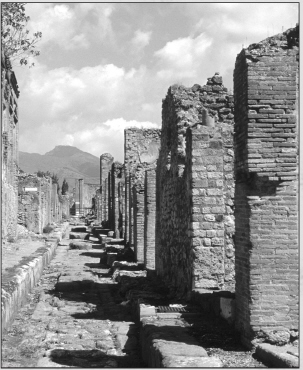

LOST
AND FOUND
Dawn Purney

ASTONISHING HEADLINES
| Attacked | Missing |
| Captured | Shot Down |
| Condemned | Stowed Away |
| Kidnapped | Stranded at Sea |
| Lost and Found | Trapped |

Copyright 2005, 2013 by Saddleback Educational Publishing
All rights reserved. No part of this book may be reproduced in any form or by any means, electronic or mechanical, including photocopying, recording, scanning, or by any information storage and retrieval system, without the written permission of the publisher. SADDLEBACK EDUCATIONAL PUBLISHING and any associated logos are trademarks and/or registered trademarks of Saddleback Educational Publishing.
ISBN-13: 978-1-61651-922-3
ISBN-10: 1-61651-922-3
eBook: 978-1-61247-079-5
Printed in Guangzhou, China
0000/CA00000000
17 16 15 14 13 1 2 3 4 5
Photo Credits:
CONTENTS
Explore the mysteries behind the famous stories of things lost and found.
The city of Pompeii in Italy had long been forgotten when a farmer found a piece of it under his field. Although the city was lost long ago, people still find pieces of the buildings, the cookware, and sometimes, even human remains. As each piece is found, the world learns a little more about the past.
We know everything there is to know about famous pilot, Amelia Earhart. Everything, that is, except why and where her plane went down on her last flight. Modern searchers have found some clues. But so far, no one knows for sure what happened to this famous pilot.
When Adriana Scott visited another college, many people greeted her as if they knew her. Imagine her surprise when she later met her identical twin. Neither girl knew she had a sister, let alone an identical twin sister!
Modern technology brought a dog back to its owner. After three years of wandering, a woman found Tuffy 32 miles from home. All it took was a scanner to tell where Tuffy belonged!
The story of the HMS Beagle might sound like another dog story, but it is not. The Beagle was the ship a famous scientist traveled in. The Beagle was soon forgotten. One day, people started looking for the Beagle. They might have found it. But it was not floating in water, it was buried in mud.
As technology develops, people continue the search for their lost items. What would you like to find?
DATAFILE
Timeline
August 79 CE
Mount Vesuvius erupts. The city of Pompeii is buried under 19 to 20 feet of ash.
1748
The city of Pompeii is found.
Where is Pompeii?

Key Terms
amphitheater an open, oval arena with seats around it
artifact a man-made object from a period in the past
CE Common Era; the years from 1 to the present
erupt to explode violently
Mount Vesuvius a volcano in Italy that has been active for centuries
Did You Know?
The 79 CE eruption of Vesuvius was the first ever to be described in detail. Pliny the Younger watched the eruption from 18 miles away. His uncle, Pliny the Elder, led a rescue team to save the people of Pompeii. Pliny the Younger wrote about the eruption in two letters that were found hundreds of years later.
CHAPTER 1
PompeiiA Lost and Found City
The Volcano Destroys a City
How does one lose an entire city? It is not as hard as it sounds! A volcano covered a city in 23 feet of ash. No one could live there anymore. Over time, people forgot the covered city altogether. The story of Pompeiis disappearance begins almost 2,000 years ago, in 79 CE.
Mount Vesuvius was a fiery volcano. It had erupted before; it would erupt again. But this time, Mount Vesuvius destroyed an entire city and all the land around it. Unlike other eruptions before, people in the area had only one days warning about the eruption.
Hot ash from the volcano started fires in Pompeii. A rescue team tried to get to the city by boat. By the time they came close, the volcano was erupting. Sadly, most of the rescue team also died.
The eruption itself is not what killed the people of Pompeii. It was the huge rocks and burning ash that rained down on the city. Poisonous gases made people choke and gasp for air. Soon the city was completely covered in ash.
Many survivors moved away. Some moved closer to other family members. Some just moved to get away from the sad memories. Over time, no one was left who remembered the city of Pompeii.
The Discovery
In 1734, a farmer dug a well in his field. As he dug, he discovered valuable pieces of marble. He thought he could sell them. A shopkeeper bought the marble for a very good price.
In turn, a local prince bought the marble. He asked the shopkeeper where he could get more. Later, the prince bought the land from the farmer. The prince began to dig. He started to uncover an entire building, but he never finished the job.
Later, another ruler hired many people to uncover the building. They did not know what they had found, but they knew it was something interesting. In time, the searchers found a statue with the word Pompeii on it. It was the name of a city they had only heard about. They were the first people to see the city for more than 1,500 years!
Uncovered
The men also found what looked like a body. The ash had surrounded the body and then hardened. The body decayed over time, leaving the ashrock mold in its place. As they found more bodies, people were able to learn about life long ago. They even found a dogs body outside one of the houses.
Besides people and animals, many buildings, homes, and shops in the city were uncovered. The ash even kept the paint colors from fading during all that time.
The men also found a huge amphitheater. There were seats for 10,000 people. It is one of many buildings that has been completely uncovered and cleaned up.
Today
Mount Vesuvius has erupted more than 30 times since it buried Pompeii. The last eruption was more than 60 years ago. Although Mount Vesuvius has not erupted lately, it is still active. In fact, the only active volcanoes on mainland Europe are in Italy. Scientists warn that any active volcano could erupt again with little or no warning.
Visitors can travel to the area today. Two small villages nearby that were also buried, now have been rebuilt into small cities. No one lives in Pompeii. But it is a popular tourist attraction.
Pompeii in the Modern World
Parts of our own culture have been influenced by Pompeii. For example, artists today use a shade called Pompeii red after the bright red color found on the city murals.

Ruins of the ancient city of Pompeii
Also, the word lava comes from Italy. The Italian word lava means a stream caused suddenly by rain. People watching Vesuvius erupt saw the molten rock flowing down the mountain. They did not know what to call it, so they used the word
Next page















